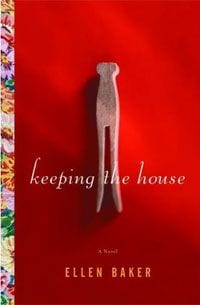
This is a novel about a mansion in Wisconsin, the family who lived in it from 1896 until the aftermath of World War II, and the young wife who becomes fascinated by its lonely, empty grandeur in 1950. This first novel by Ellen Baker is a family saga, steeped in the history of the two world wars, whose characters are brought together by this house. At its best, Keeping the House savors of works by Willa Cather and Marilynne Robinson.
Wilma Mickelson, the new wife of John Mickelson, arriving at her new home in Pine Rapids, Wis., in August 1896, could easily be one of Cather’s oppressed artist characters. Her first thought on the train platform: “She had abandoned college, her piano, for this!” Wilma, we quickly learn, is destined to be very unhappy in this house — she’s not meant to be the wife of a rich businessman and the mother of his children, but that’s what a foolhardy decision has bequeathed her.
Dolly Magnuson, on the other hand, loves this dove-gray house on a hill. She sees it for the first time in 1950 when her new husband, a war vet, takes a job in Pine Rapids selling cars. Like Wilma, Dolly also has unwifely aspirations — she’d like to fly airplanes — and she, too, is frustrated by a husband and a society that prescribe a far narrower role to women. So she joins the Ladies Aid Society, meeting in the house across the street from the mansion, and while quilting with the old women of the town, she hears the tale of Wilma and the ill-fated Mickelson family. The house, the women tell her, is cursed.
Baker has done a fine job of setting up the two narratives that first develop separately, like pieces of a quilt, and then are sewn together, part of the same fabric in the end. Her knowledge of American cultural history serves her extremely well. For example, Dolly’s chapters begin with quotes from domestic manuals of the era, such as this from a 1950 Ladies’ Home Journal article, “Making Marriage Work”:
“Married happiness can never be taken for granted. … You expect your husband to continue his efforts to advance in his field; similarly you should continue your efforts to improve in your job as housekeeper, mother, and wife.”
Dolly does her best to be the perfect wife, cooking a variety of meals for Byron — Chicken a la King, tuna casserole, Swiss steak, apricot cottage cheese salad — that bring the 1950s vividly to mind for modern-day readers. She wears sexy negligees for her husband, keeps his shirts ironed and their bungalow spotless, but still her marriage is troubled.
Lonely and unsatisfied, Dolly begins a secret life with the old Mickelson house. She sneaks in to clean it, and soon knows much more about its former inhabitants than even the old ladies across the street. Dolly is trying to fill the emptiness in her marriage with the empty mansion. After all, Byron won’t talk to her about the war, but she knows from the nightmares that leave him sweating and shaking that he has seen terrible things.
Ellen Baker’s expertise as a former curator of a World War II museum permeates the novel. Her knowledge of the lives the soldiers led in the Pacific and European theaters is pitch-perfect. What the battle-scarred men can’t tell their wives and mothers is running constantly through their minds, as in these thoughts from a Marine who survived Iwo Jima:
“The days rolled together: sweat, filth, stink, lice, horror, rain, sun, steam. You were a killer, for brief moments omnipotent. Afterward, you kicked the enemy to be sure he was dead and dug in his shirt pocket for the picture of himself each warrior carried, which became a souvenir for your own pocket. Moments later, you saw friends die. You were helpless to save them, and you wore your anguish on your skin. You didn’t know the way out, except to keep fighting. You trusted you would die soon enough, though you would do your best not to.”
Baker shows us two generations of American men mentally battered by war. Those who didn’t lose limbs or lives in one of the two world wars lost something else and, inevitably, they brought their losses back with them. She also knows what life was like for the women left at home, the grieving widows and mothers, the nurses who treated the damaged men and perhaps understood them better than anyone else.
Paradoxically, the archival data underpinning this novel is so rich that the family saga of the Mickelsons is sometimes stretched thin across the cultural background of the era. The family secrets are shocking, but so much historical material interlards them that they don’t pack the punch they might have in a shorter, tighter narrative.
Despite that caveat, Baker has scored a victory with Keeping the House. For all its length, it flows smoothly, and the prose is so assured, it’s difficult to believe this is the author’s first novel. Baker’s future as a fiction writer looks promising — as prosperous as the halcyon decades that followed World War II in America.

![Call for Papers: All Things Reconsidered [MUSIC] May-August 2024](https://www.popmatters.com/wp-content/uploads/2024/04/all-things-reconsidered-call-music-may-2024-720x380.jpg)



